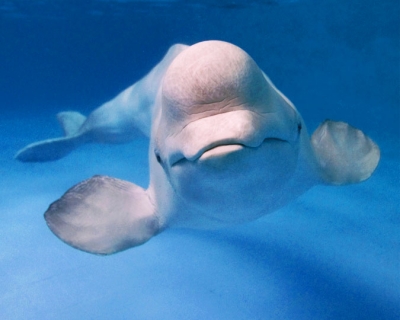
Beluga whales are white whales that live in the Arctic. They attract a lot of attention to themselves because of their unique color and the lack of a dorsal fin. Unfortunately, they are kept in captivity more than any other whale or dolphin species. Due to the irresponsible behavior of humans they are now on the edge of extinction. Belugas are pretty and friendly white whales, and their color helps them to stay alive and protects them from danger. There are many interesting facts about the Belugas that you should know and share with your kids.
Belugas are toothed whales, but they never chew their food. They swallow their prey. Another reason why the Beluga Whale is an endangered species is the fact that they have babies only once in three years. The female Beluga always gives birth to one calf and nurses it until it’s two years of age. The period between conception and birth for Beluga whales is 15 months. So, all in all, a female Beluga can give birth to only one new offspring every three-and-a-half years. The word Beluga comes from the Russian word for white. Although, they are born dark-grey, and it takes eight years for them to turn completely white. Amazing, right? Beluga whales can swim backwards. Beluga whales, just like dolphins, have been known to save people’s’ lives by pushing them to the surface when they are drowning. A captive Beluga saved a free diver’s life in 2009 while she was competing. This fact only confirms how good animals are to us even after all the cruelty they suffer. The Belugas are threatened mostly by being captured for captivity, hunting, climate change, oil and gas development, and industrial pollution. The wild predators that hunt them are Orcas and polar bears. Beluga whales are also known as the canaries of the ocean because of their incredible capability to produce different sounds. Scientists recorded eleven types of sounds that Belugas use to communicate with each other, to identify objects or calculate distance. They have a bulbous structure in their forehead that serves as an echo box where all the sounds come from. High-pitched whistles, clicks, mews, bleats, chirps, and bell-like tones are some of the sounds recognized by scientists. The Beluga’s neck is incredibly flexible and can move up and down and left and right. Such neck flexibility helps the whale to spot their prey easily. Beluga whales living in captivity have been recorded mimicking the human voice. It’s quite amazing to hear them imitating the human voice, but on the other hand, that means they spend so much time surrounded by people in an environment that is not their natural habitat. Beluga whales are highly social creatures that like to communicate with each other and with other species as well. They live in groups called pods, and they travel together everywhere. To spot them in real life, you must visit the Arctic Ocean coastal waters where they spend most of their time. Belugas can live 70 to 80 years, though in captivity they only reach a half of that age. Beluga whales can dive up to 25 minutes non-stop, and reach depths of 2624 feet. The beluga can change the shape of its bulbous forehead, called a “melon”, by blowing air around its sinuses.
Credit : Out door revival
Picture Credit : Google




